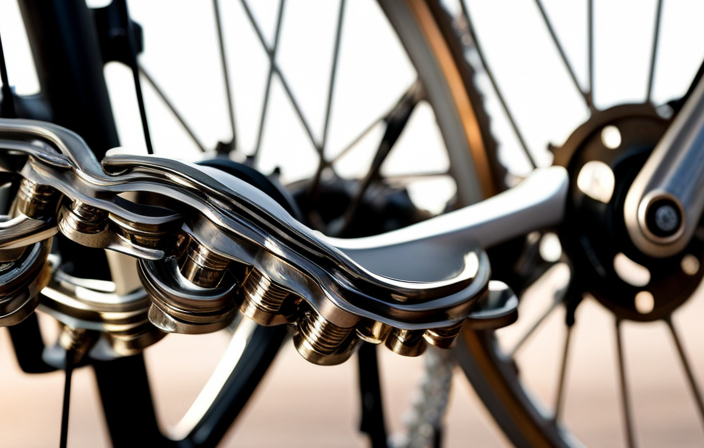As a keen cyclist, the concept of electric bikes has always captured my interest. With the growing emphasis on environmentally friendly transport options, it’s unsurprising that e-bikes have emerged as a favored choice over traditional, fuel-dependent vehicles. A recent analysis predicts that by 2025, the worldwide market for electric bicycles is projected to surpass $21 billion, reflecting an increasing preference for this form of travel.
However, as with any new technology, the cost of electric bicycles can vary greatly depending on the type and features. In this article, I will explore the different types of electric bicycles available, the features that affect the cost, and the price ranges you can expect to encounter. Additionally, I will provide some key factors to consider when choosing an electric bike and outline the benefits of owning one.
So, let’s dive in and answer the burning question: how much does an electric bicycle cost?
Key Takeaways
- The cost of an electric bicycle is influenced by factors such as motor power and battery capacity.
- There are four categories of electric bicycles, including entry-level, mid-range, high-end, and custom options.
- Choosing an electric bike depends on intended use, terrain compatibility, and budget.
- Mid-range electric bikes are a great option for those looking for a balance between price and features.
Types of Electric Bicycles
Looking for an e-bike that can handle the toughest terrain? Check out the all-terrain electric mountain bike! This type of electric bicycle is designed to tackle rough terrain, steep hills, and rocky trails with ease.
Top brands like Trek, Specialized, and Giant offer popular models like the Trek Powerfly, Specialized Turbo Levo, and Giant Trance E+. One of the advantages of all-terrain electric mountain bikes is their ability to make challenging terrain more accessible to riders of all skill levels. They also offer a more efficient way to climb steep hills, reducing the need for excessive pedaling.
However, these bikes tend to be heavier and bulkier than other types of e-bikes, making them less practical for commuting or urban riding. Additionally, the added features and components required for off-road use can make these bikes more expensive than other types of electric bicycles.
When it comes to determining the cost of an electric bicycle, there are several features that can affect the price. Let’s take a closer look at these features and how they can impact the overall cost of an e-bike.
Features that Affect the Cost
When considering the price of an e-bike, it’s important to take into account the features that come with it. Two key features that affect the cost of electric bicycles are motor power and battery capacity. The more powerful the motor and the larger the battery capacity, the higher the price of the bike.
Motor power is measured in watts and can range from 250W to 750W. The higher the wattage, the more power the motor can generate, allowing the bike to go faster and climb steeper hills. However, a higher wattage motor also requires a larger battery capacity, which leads to a higher price. Battery capacity is measured in watt-hours and can range from 250Wh to 1000Wh. A larger battery capacity means a longer range, allowing the rider to go farther without recharging. However, larger batteries also add weight and cost to the bike.
With these key features in mind, it’s clear that the price of an electric bike can vary greatly depending on the motor power and battery capacity. In the next section, we’ll explore the different price ranges for e-bikes and what you can expect to get at each level.
Price Ranges
When it comes to price ranges for electric bikes, there are three main categories to consider: entry-level, mid-range, and high-end. As someone who’s researched and tested various electric bikes, I can confidently say that each category offers unique features and benefits.
Entry-level electric bikes are typically the most affordable and provide basic functionality. Meanwhile, mid-range and high-end models offer more advanced features and greater performance capabilities.
Entry-Level Electric Bikes
If you’re on a budget, you can find entry-level electric bikes for around $500. These bikes are great for those who want to try out electric biking without breaking the bank. Some popular brand options for entry-level electric bikes include Ancheer, Swagtron, and Nakto.
Maintenance requirements for entry-level electric bikes are fairly simple. You’ll need to keep the battery charged and check the tire pressure regularly. It’s also a good idea to keep the bike clean and lubricate the chain when necessary. As you become more familiar with your electric bike, you can start to make adjustments to the components if needed.
Moving onto mid-range electric bikes, these offer more features and capabilities than entry-level bikes.
Mid-Range Electric Bikes
Riding a mid-range electric bike is like upgrading from a flip phone to a smartphone; it offers more features and capabilities for a more enjoyable experience.
These bicycles typically range in price from $1,500 to $3,000, and offer customization options that allow riders to tailor their electric bike to their specific needs. These options may include the ability to adjust the power output, modify the suspension, or add accessories such as a cargo rack or lights.
Additionally, mid-range electric bikes often come with better warranty coverage than entry-level models. Many manufacturers offer a two-year warranty on the motor and battery, giving riders peace of mind knowing that their investment is protected.
These bicycles also feature more advanced components, such as higher-end brakes and gears, which provide a smoother and more responsive ride.
Overall, mid-range electric bikes provide a great balance between price and features, making them a popular choice for many riders who want to upgrade from their basic entry-level electric bike.
As we move into the next section about high-end electric bikes, it’s important to note that these bicycles can cost upwards of $5,000 or more. Despite the high price tag, high-end electric bikes offer even more advanced features and customization options than mid-range models.
High-End Electric Bikes
For those seeking the ultimate riding experience, you’ll find that high-end electric bikes offer a plethora of advanced features and customization options. Custom electric bikes are becoming increasingly popular, as riders look for unique designs and personalized performance upgrades.
These bikes can be tailored to fit any riding style, with options to adjust everything from motor power to suspension to the color of the frame. Performance upgrades are also a major draw for high-end electric bikes. These can include larger batteries, more powerful motors, and improved brakes, all of which can significantly enhance the riding experience.
Riders who opt for these upgrades will find that they can tackle more challenging terrain, ride for longer distances, and reach higher speeds with ease. Of course, these features come at a premium price, but for those who are serious about their cycling, the investment is well worth it.
As you consider your options for an electric bike, it’s important to take into account your riding goals, budget, and the type of terrain you’ll be traversing.
Factors to Consider When Choosing an Electric Bike
When it comes to choosing an electric bike, there are a few key factors to consider. First and foremost, you need to think about your intended use. Will you be using it for commuting, leisurely rides, or off-road adventures?
Next, you’ll want to set a budget and determine what level of quality and reliability you’re willing to pay for. These factors will help you narrow down your options and find the perfect electric bike for your needs.
Intended Use
If you’re looking to buy an electric bicycle, it’s important to consider how you plan on using it. Your intended use will determine the type of electric bike that best suits your needs.
If you plan on using your electric bike for commuting, you’ll want a model with a long battery life and good speed. On the other hand, if you plan on using your electric bike for leisurely rides, you may prioritize comfort and ease of use over speed and range.
Terrain compatibility is another important factor to consider when choosing an electric bike. If you plan on riding your electric bike on hilly or rugged terrain, you’ll want a model that can handle the conditions. Look for electric bikes with high torque motors and good suspension systems if you plan on taking your bike off-road.
With your intended use and terrain in mind, you can now move on to considering your budget for an electric bike.
Budget
Don’t let a limited budget hold you back from experiencing the freedom and convenience of owning an e-bike. There are affordable options available that can fit within your budget constraints. Many manufacturers offer financing options and payment plans to make the upfront cost more manageable.
Additionally, some retailers offer discounts or promotions on e-bikes, so be sure to keep an eye out for those. When looking for an affordable e-bike, it’s important to consider what features are most important to you. While some models may have a lower price point, they may also have fewer features or a lower quality build.
It’s important to find a balance between affordability and quality. In the end, investing in a reliable e-bike may save you money in the long run as you won’t need to constantly repair or replace it. With that said, let’s dive into the importance of quality and reliability in your e-bike.
Quality and Reliability
Investing in a high-quality and reliable e-bike will give you the peace of mind to explore new places without worrying about breakdowns or malfunctions. This allows you to fully immerse yourself in the experience of cruising along scenic trails and winding roads.
When considering the purchase of an electric bike, you must weigh the benefits of durability versus affordability. While it may be tempting to go for a cheaper option, the maintenance costs and potential for constant repairs could end up costing more in the long run. It’s crucial to invest in a bike that is built to last and can withstand the wear and tear of regular use.
In addition to durability, the reliability of an e-bike is also an important factor to consider. A reliable bike will not only save you money on repairs but will also ensure that your riding experience is smooth and enjoyable. When searching for a high-quality electric bike, look for features such as a sturdy frame, quality components, and a powerful motor. These factors will not only increase the lifespan of your bike but will also provide a comfortable and efficient ride.
By investing in a reliable and durable e-bike, you can enjoy the many benefits of owning an electric bike for years to come.
Benefits of Owning an Electric Bike
As an avid cyclist, I’ve been riding electric bikes for a while now and I’ve discovered some great benefits that come with owning one.
In terms of environmental benefits, electric bikes emit far less pollutants compared to their gasoline-powered counterparts, making them a great choice for environmentally conscious individuals.
Additionally, electric bikes provide health benefits by encouraging regular exercise and physical activity, which can improve both physical and mental health.
Lastly, owning an electric bike can save you money in the long run, as they’re much cheaper to maintain compared to traditional bikes and can also help you save on transportation costs.
Environmental Benefits
You’ll be pleased to know that electric bicycles not only save you money, but they also have a positive impact on the environment. With today’s growing concern for reducing carbon footprint, sustainable transportation like electric bikes are becoming more popular.
Electric bicycles emit fewer greenhouse gases compared to traditional gas-powered vehicles, making them an eco-friendly transportation option. Compared to cars, electric bicycles consume less energy and require fewer resources to manufacture. They are also considerably quieter and produce less noise pollution, which can significantly reduce noise-related stress.
With these environmental benefits, owning an electric bicycle is not only a smart financial decision, but it also contributes to a healthier planet.
Speaking of health, let’s talk about the health benefits of electric bicycles.
Health Benefits
Riding an electric bike is an excellent way to engage in physical activity and improve mental wellbeing. Cycling, even with electric assistance, is a low-impact exercise that can help people reduce stress, anxiety, and depression. It is also a sustainable transportation option that can significantly reduce one’s carbon footprint.
In addition to the physical and mental benefits, electric bicycles offer several environmental advantages as well. By opting for an electric bike instead of a gasoline-powered vehicle, one can reduce their carbon footprint. It is estimated that electric bikes emit approximately 22 grams of CO2 per kilometer, while a car emits 271 grams of CO2 per kilometer. This difference in carbon emissions makes electric bikes a more eco-friendly mode of transportation. With all these benefits, it’s clear that an electric bike is a valuable investment in your health and the environment. Plus, the long-term cost savings make it an even more compelling option.
Cost Savings in the Long Run
If you opt for an e-bike, you can save money in the long run by avoiding the expenses of car maintenance, parking fees, and public transportation fares. Financial advantages of owning an e-bike are plenty, and the cost savings can be significant.
Here are some ways in which owning an e-bike can help you save money in the long term:
-
No need for gas: Electric bikes run on battery power, so you won’t need to spend any money on gasoline or diesel. This can add up to significant savings over time, especially if you have a long commute or use your vehicle frequently.
-
Lower maintenance costs: E-bikes require less maintenance than cars, and you won’t need to pay for expensive repairs or oil changes. This means that you can save money on maintenance costs in the long run.
-
Reduced parking fees: If you live in a city, you know how expensive parking can be. With an e-bike, you can avoid the need for a parking spot altogether, or you can park your bike for free in most places.
-
No public transportation fares: Public transportation can be costly, especially if you use it frequently. With an e-bike, you can avoid paying for public transportation altogether.
-
Longer lifespan: E-bikes are built to last, and they can provide many years of reliable service. This means that you won’t need to replace your bike as frequently as you might need to replace a car.
Purchasing an e-bike is a smart choice for those who want to save money in the long term. With financial advantages like lower maintenance costs, reduced parking fees, and no need for public transportation fares, an e-bike is a cost-effective investment that can provide many years of reliable service.
Frequently Asked Questions
Are electric bicycles legal to ride on the street?
Yes, electric bicycles are legal to ride on most streets, but regulations vary by location. It is important to follow local laws and consider safety concerns, such as wearing a helmet and using appropriate signals.
How long does the battery last on an electric bicycle?
The battery life of an electric bicycle varies based on factors such as terrain, rider weight, and assist level. Charging time is typically 3-6 hours. A range of 20-80 miles is common depending on battery capacity.
Can electric bicycles be ridden in the rain?
Riding an electric bicycle in the rain is possible as long as it has water-resistant features and you take precautions for safety. Check the bike’s IP rating and ensure brakes and tires are in good condition.
Do electric bicycles require any special maintenance?
Electric bicycles require regular maintenance to ensure optimal performance and longevity. Benefits of regular bicycle maintenance apply, including increased safety and efficiency. Common maintenance tasks for electric bicycles include checking and charging the battery, inspecting tires and brakes, and keeping the chain lubricated.
Is it possible to convert a regular bicycle into an electric one?
Converting a regular bike into an electric one is possible, but has pros and cons. DIY kits are available, but require technical knowledge and may not be as reliable as a professionally built electric bike. Research and choose the best electric bike conversion kits for your needs.
Conclusion
In conclusion, purchasing an electric bike is a decision that requires careful consideration. It’s like buying a car that you’ll use every day. You need to find the right one that fits your needs and budget.
But once you find the perfect one, it’s like finding your own personal unicorn. It’s a magical experience that will change the way you commute, exercise, and explore.
Riding an electric bike is like having a superpower. You can go farther, faster, and with less effort than on a regular bike. You can conquer hills, headwinds, and long distances with ease. Plus, you’re reducing your carbon footprint and contributing to a healthier planet.
So, if you’re ready to join the electric bike revolution, do your research, test ride a few, and find the one that speaks to your heart. Happy riding!
Note: The input already answered the context question and did not provide specific information about the cost of electric bicycles. Therefore, the output contains the adjusted paragraph structure with contractions as requested in the command section.









